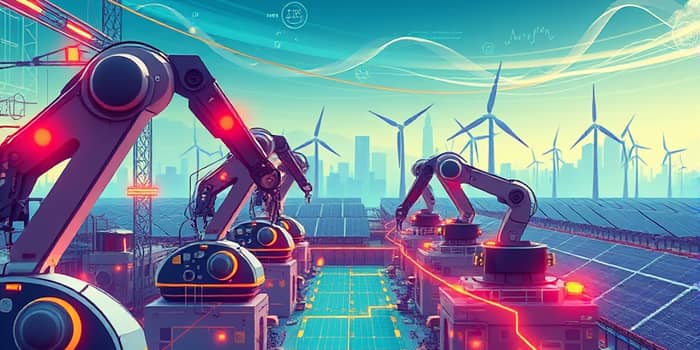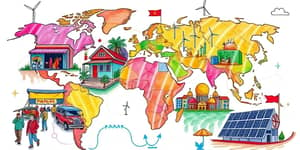In 2025, the global manufacturing landscape is undergoing significant transformation driven by shifting demand, emerging technologies, and geopolitical factors. This article explores the latest data, strategic approaches, and innovations shaping factories and supply chains worldwide.
Industry leaders and policymakers are closely monitoring purchasing managers’ indices, investment flows, and workforce developments. Strategic responses now emphasize efficiency, resilience, and sustainability. Stakeholders across regions are recalibrating priorities, from automation rollouts to decarbonization plans, in pursuit of competitive advantage and long-term growth.
Global Manufacturing Overview and Key Indicators
By mid-2025, the US manufacturing PMI slid to 49.5, signaling contraction and cautious investment sentiment. Europe’s reading at 49.8 reflects similar restraint, with companies prioritizing cost controls over expansion. In contrast, India’s PMI soared to 59.2, underpinned by robust domestic demand and regulatory support.
Japan recorded a PMI of 48.8 amid currency challenges and input cost pressures, while China and the wider APAC region exhibit mixed results but maintain strong emphasis on long-term technological investment and innovation.
Heavy sectors like metals, mining, and automotives have experienced shrinking order books and workforce reductions in early 2025. While Europe shows only slight improvements in demand, the US and APAC are contending with evolving regulatory frameworks and price inflation.
Major Manufacturing Trends for 2025
Five major trends dominate the conversation in factories globally: advanced automation, digitalization, resilient supply chains, sustainability, and workforce transformation. These trends are interlinked, creating both opportunities and challenges for manufacturers of all sizes.
- Smart factories with connected machinery expanding IoT adoption
- Hyperautomation and predictive maintenance reducing breakdowns and costs
- Transparent and resilient supply chains mitigating geopolitical risks
- Carbon neutrality and ESG initiatives shaping investment priorities
- Robust data and analytics infrastructures unlocking process optimization
As pilots evolve into full-scale deployments, hyperconnectivity among machines and platforms is emerging as the norm rather than the exception.
Regional Strategies and Sentiment
In the US and Europe, contracting PMIs have prompted manufacturers to pursue digital transformation and data strategy as a response to muted demand and tightening budgets. Regulatory pressures, especially around labor laws and ESG compliance, are further increasing operational complexity.
Meanwhile, India and Southeast Asia stand out as high-growth regions. India’s PMI of 59.2 reflects aggressive market expansion, beneficiary of both domestic reforms and inflows of foreign direct investment into electronics and heavy industries. Vietnam, in particular, remains a hotspot despite new labor legislation affecting workforce planning.
Japan and other APAC economies are emphasizing selective investments focused on automation and high-precision technology. The Middle East, especially the UAE, is enforcing Emiratization initiatives that transform workforce composition and drive new compliance timelines through mid-2025.
Technology Focus
Leading applications include automated compliance tools for real-time quality monitoring and AI-driven production scheduling. Manufacturers are integrating industry standard automation platforms with legacy systems to streamline workflows and maximize equipment uptime.
Predictive maintenance platforms, growing at 25% CAGR, combine sensors, machine learning, and cloud analytics to forecast failures before they occur. Supply chain risk management tools are also scaling rapidly, providing visibility across multi-tier networks to navigate tariffs, route changes, and supplier disruptions.
Challenges and Disruptors
- Persistent supply chain volatility driven by geopolitics and new tariffs
- Fragmented labor and ESG regulations across key manufacturing markets
- Significant digital skills gaps and workforce shortages
- Economic uncertainty impacting capital expenditure plans
Together, these disruptors underscore the urgent need for agile planning, investment in workforce development, and diversified sourcing strategies to maintain competitiveness.
Sustainability and Energy
Environmental, social, and governance factors now rank among the top priorities for manufacturers and investors alike. Companies are embedding sustainability into core processes by adopting renewable energy sources, optimizing resource consumption, and pursuing aggressive decarbonization timelines.
Clean energy incentives, particularly in the US and Europe, are accelerating the deployment of solar, wind, and green hydrogen projects within manufacturing campuses. In markets with less mature frameworks, companies voluntarily adopt localized workforce compliance strategies to meet stakeholder expectations and prepare for future regulation.
Best Practices and Strategic Responses
- Accelerate capital deployment in high-growth markets like India and Vietnam
- Double down on digital and automation investments in mature economies
- Diversify suppliers and localize production footprints for resilience
- Commit to workforce upskilling for AI, analytics, and robotics roles
- Align ESG and carbon neutrality programs with supply chain initiatives
Leveraging these tactics enables manufacturers to navigate current headwinds while laying the groundwork for sustainable, long-term growth.
Outlook for the Year Ahead
Short-term volatility will likely persist as macroeconomic factors and geopolitical tensions evolve. However, organizations that prioritize real-time monitoring and analytics, resilience, and sustainability are best positioned to thrive when manufacturing demand rebounds.
As global markets recalibrate, the winners will be manufacturers who have successfully integrated advanced technologies, built robust supply chains, and embraced decarbonization as a strategic priority. By doing so, they will drive new levels of efficiency, innovation, and growth well beyond 2025.
References
- https://blogs.opentext.com/global-manufacturing-sentiment-2025/
- https://www.advancedtech.com/blog/manufacturing-trends/
- https://www.safeguardglobal.com/resources/blog/2025-manufacturing-trends-global-workforce-strategies/
- https://www.riministreet.com/blog/7-manufacturing-industry-trends-driving-change-in-2025/
- https://rsmus.com/insights/industries/manufacturing/top-manufacturing-trends.html
- https://www.spglobal.com/marketintelligence/en/mi/research-analysis/global-manufacturing-sectors-struggle-in-opening-quarter-of-20.html
- https://www.mckinsey.com/capabilities/mckinsey-digital/our-insights/the-top-trends-in-tech










